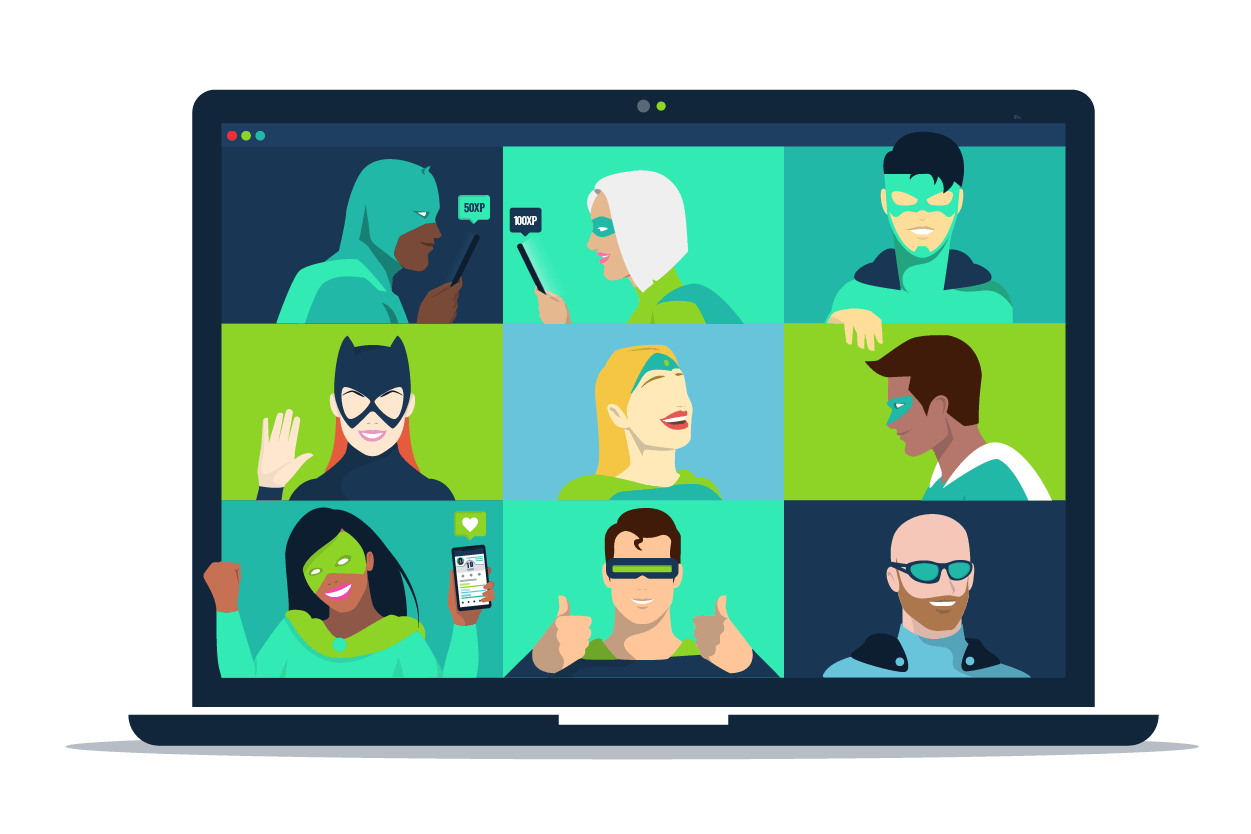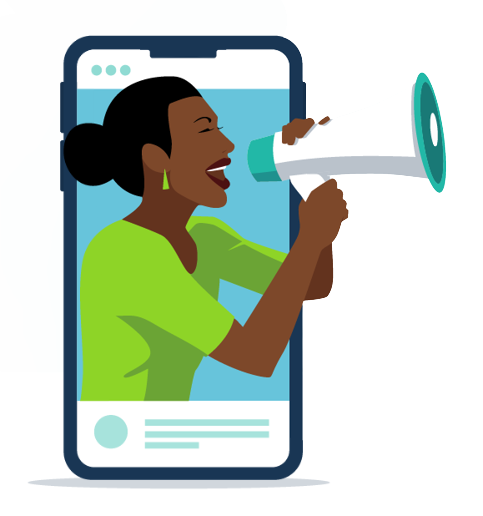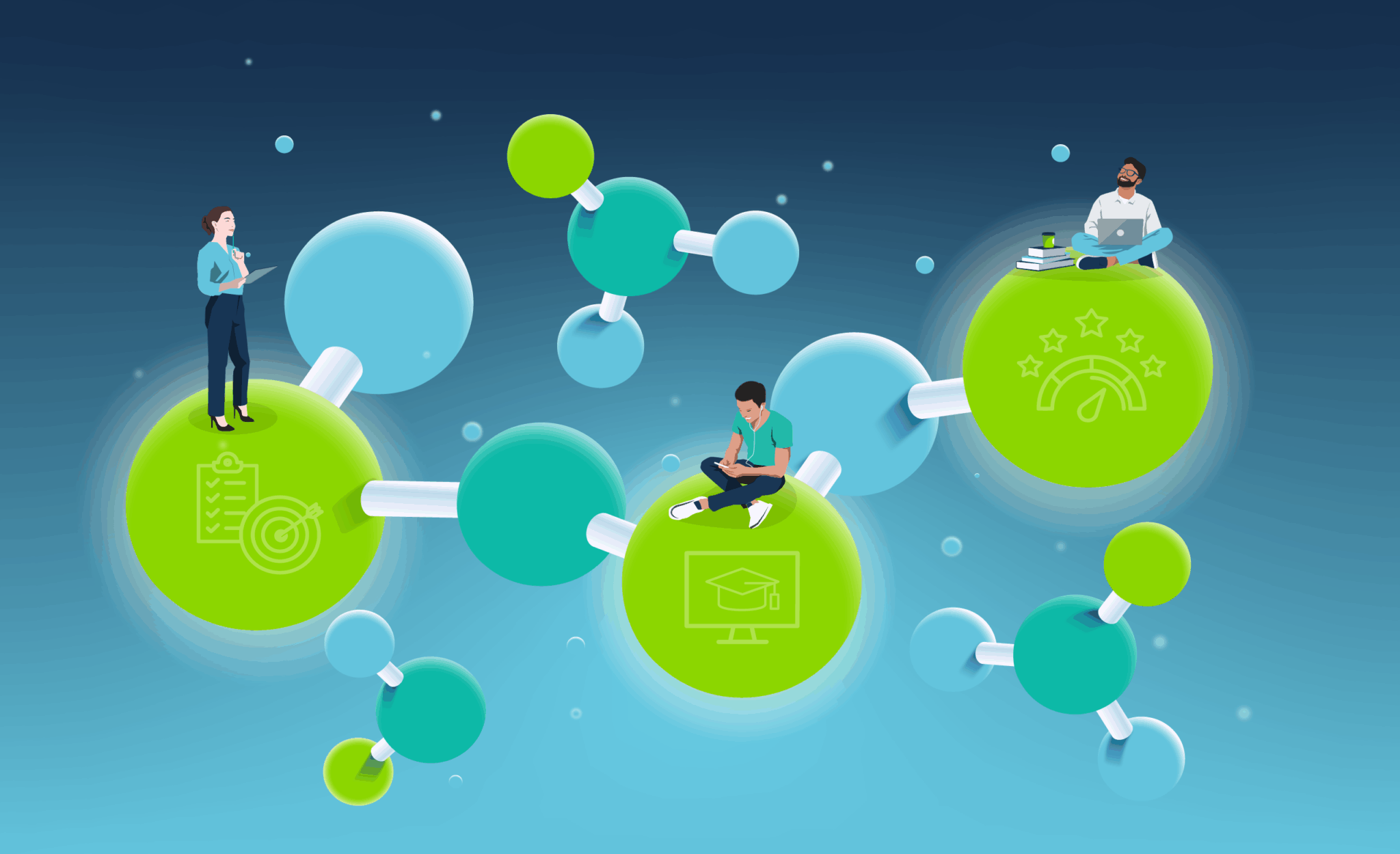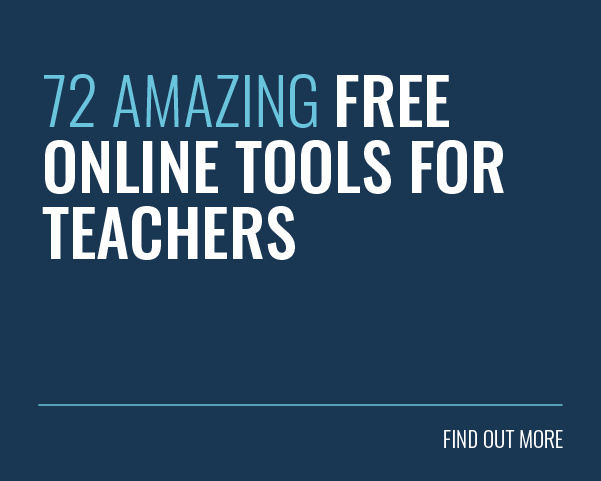The world of learning and development has undergone vast changes over the last decade. We now understand that it’s not just the quality of our learning experiences that make a difference. The way we deliver these experiences matters too. Enter the learning campaign.

The importance of a learning culture, spaced repetition and continuous learning is hard to dispute. Learning campaigns help to tick all these boxes whilst providing a more learner-friendly experience.
Learning campaigns draw inspiration from the world of marketing and advertising to deliver training in new and more effective ways. By adopting a more strategic and integrated approach to learning, organisations can foster a continuous learning culture and reinforce key messages.
But what exactly is a learning campaign, and what are the benefits? We’ll explore these questions in this article.
Ready? Let’s get learning!
What Is a Learning Campaign?
Learning isn’t a one-off event. It’s a journey that takes place over time as we absorb, contextualise and put new information into practice.
That’s where learning campaigns come in! In a nutshell, a learning campaign is a series of learning initiatives delivered over a period of time that are designed to promote and facilitate a cohesive learning and development experience.
As such, learning campaigns typically involve a series of planned and structured learning activities that help your learners to acquire new skills, knowledge and competencies. In turn, this should help them improve their performance and achieve learning goals.
Learning campaigns can take various forms. You can include, for example, online courses, workshops, webinars, mentoring and coaching. Similarly, you can focus on a specific topic, like leadership or sales skills, or you can create more general campaigns that cover a range of topics.
Regardless of your approach, the goal is to create a continuous learning experience where learners build their knowledge and skills over time. Ultimately, by providing access to the right resources at the right moment, you should help your learners to change their behaviour and improve their learning outcomes.
Learning campaigns come with a bounty of benefits. In fact, by investing in learning campaigns, you can improve engagement and promote innovation and growth. We’ll explore the benefits in more detail later on in the article.
Marketing Origins
The phrase ‘marketing campaign’ should ring a bell for most of us, regardless of whether you work in marketing or not.
A marketing campaign involves a series of activities or messages that contribute towards a larger marketing goal. In fact, the average consumer journey involves 20-500+ touchpoints.
Learning campaigns take on this marketing approach by focusing on delivering information through numerous touchpoints.
However, it’s clear that learning and marketing are two different things. Marketing typically focuses on driving potential customers towards a relatively simple outcome, like a sale.
Long-term learning is a more complex process. After all, learners typically require more support and nudges to build their knowledge and make behaviour change stick. As a result, learning campaigns are often more complex in nature than their marketing equivalents.
The Benefits of Using a Learning Campaign
You now have an idea of what marketing campaigns are all about. Let’s move on to the benefits of utilising learning campaigns:
1. Improve Knowledge Retention
Implementing a learning campaign taps into the power of repetition to improve knowledge retention. In fact, your campaign promotes learning activities and content over a period of time.
This kind of instructional scaffolding enables your learners to build upon their knowledge.
The spacing between each point of contact is essential. Your training units should get progressively more challenging whilst also repeating your most important training messages. This will help to reinforce desired learning outcomes.
2. Fight Against the Forgetting Curve
Hermann Ebbinghaus, a German psychologist, tested his memory over a period of time. He then created a memory loss model based on his findings.
The Forgetting Curve shows that we forget a whopping 50% of new information within a day. Furthermore, we forget 90% of information within a week if we don’t try to retain it.
The increased knowledge retention of learning campaigns helps you to fight against the curve. After all, Ebbinghaus found that spaced repetition dramatically helps in the battle against forgetting.
3. Create a Continuous Learning Culture

Learning campaigns focus on long-term training that reinforces knowledge and builds upon your learners’ skills. This consistent learning approach also helps you to create a continuous learning culture across your organisation.
A continuous learning culture is extremely beneficial for organisations and learners alike. After all, it helps you to promote growth, adaptability and innovation.
This, in turn, helps you to gain a competitive advantage as you boost your employees’ skills and stay ahead of the curve.
4. Encourage Behaviour Change
Behaviour change is the ultimate goal of any learning and development initiative. But behaviour change doesn’t happen overnight. In fact, it takes 66 days to form a habit.
Despite this, some organisations see learning and development as a ‘quick fix’. However, we know that true knowledge retention and behaviour change are not easy to achieve.
The human brain loves repetition. The more your learners repeat their content, the deeper they’ll forge their neural pathways. This, in turn, makes it easier for your brain to access the information again and again.
As such, campaign-based training programmes also help you to create lasting behaviour change by promoting spaced repetition.
5. Make Learning Materials Less Demanding

Successful learning campaigns take advantage of all sorts of different mediums. For instance, you can use videos, PDF files, podcasts, quizzes, images, graphics and more.
You should also utilise microlearning to break information down into bite-size chunks. This makes the content easier for learners to consume and for you to create.
This variety helps to keep your learners engaged. After all, no one wants to explore long, text-based content session after session.
What Does a Great Learning Campaign Look Like?
As an L&D professional, your job is to plan and deliver awesome learning campaigns that engage your learners and lead to long-lasting behavioural change.
But how can you achieve this in a world of digital distractions like TikTok dances and addictive mobile games?
Again, we can learn a lot from the marketing world. As such, let’s find out how we can deliver a winning learning campaign by taking some inspiration from marketing professionals.
1. Strong Value Proposition
The number-one rule of marketing is to create a strong value proposition. The most successful adverts answer potential customers’ burning desires, goals and needs they didn’t even know they had.
This is also essential for the success of any learning campaign. That’s where Epic Meaning comes in. Every aspect of your training programme should answer your learners’ key question: ‘What’s in it for me?’.
By making the personal benefits of your training clear from the get-go, you will keep your learners’ engagement levels high and convince them to invest their time and energy into the learning experience.
2. Power of Video Content
If an image says a thousand words, imagine what a video can do! Today, video is one of the most popular forms of content marketing. In fact, 91% of businesses use video as a marketing tool in 2023.
And the results speak for themselves! 96% of marketers say that videos have helped them increase their brand awareness. Furthermore, 90% say that video marketing has helped them increase traffic.
In an L&D context, videos are an excellent way to hold your learners’ interest. In fact, on average, individuals spend 2.6x more time on pages that include video content. As such, it’s clearly worth incorporating video content in your learning campaign.
3. Entertainment

The goal of marketing campaigns is to entertain, tell a story and generate interest. The best adverts are ones we want to re-watch, remember later on and tell our friends about.
Just like the most successful ads, your learning content needs to entertain to engage your learners and keep them coming back for more. The best adverts make us feel. In the same way, your learning campaign needs to trigger an emotional response.
Whether that’s to laugh, roar with triumph or ponder life in a new way, you need to make your learning campaign compelling. One way to do this, for instance, is to introduce an exciting narrative to guide your learners through their training campaign.
4. Bite-Sized Content
In today’s world of digital distractions, both marketing and learning campaigns need to be short and snappy to succeed. Learners or consumers rarely have the time or attention span to explore content that is hours long.
The best marketing campaigns include various promotional snippets, tied into the campaign’s overarching storyline. Each short instalment is full of visuals, entertaining content and a clear message.
The end result? Viewers eagerly anticipate the next bite-sized instalment of the promotional campaign.
You can harness similar levels of engagement among your learners by creating your units with microlearning in mind. By using microlearning, you can drip-feed short content units to your learners in spaced intervals.
Keep your content as engaging and meaningful as possible to trigger curiosity and build anticipation. Similarly, keep your units short and sweet. If the massively successful TED Talks can do it in under 18 minutes, so can you!
5. Social Power
Social media marketing uses the oldest and most successful marketing tool of all, word of mouth, to generate conversation and fuel consumer interest. This makes sense, given that there are over 4.89 billion social media users globally.

In fact, social media has transformed marketing from a monologue into a dialogue with consumers. Today’s most powerful brands have a strong social media presence that enables them to connect with their consumers and spread brand awareness.
You can tap into the success of social media in your online learning campaign too! You can use social learning to reinforce your training content and create lasting behaviour change.
After all, social learning features encourage learners to share their knowledge. As a result, other learners can expand their understanding of the topic based on these real-world experiences.
6. Mobile Accessibility
Last, but not least, you should ensure your learning campaign is delivered in the right format. In fact, you should ensure learners can access their training content on their desired devices, including their mobile phones.
Why? Smartphones have become the most popular device used to access the internet. It’s clear that individuals want to access information and resources conveniently and on the go.
Your learning campaign should be no different. By introducing mobile learning, you can meet your modern learners’ technological expectations and provide a training solution your learners can access whenever and wherever.
Market Your Learning Campaign to Your Learners
Once you have implemented your learning campaign, you need to market it to your learners. And what better way to do so than by taking advantage of popular marketing tactics?
After all, the purpose of marketing is to make potential customers aware of your product or services in order to move them along to make a purchase. Marketers seek to engage these prospects and speak to them in a language that resonates.
There is a four-stage process marketing professionals use to encourage customers to take action. Let’s explore these stages in the context of a learning campaign.
1. Hook

First impressions are important. A marketing campaign uses a ‘hook’ to grab the audience’s attention. Similarly, you need to hook your learners and secure their buy-in.
Your campaign needs to stand out in a world of information overload. Prominent banners and high-impact visuals will help you to grab your learners’ attention and direct their energy.
It’s up to you to create a sense of urgency that encourages your learners to pay attention to your message.
Similarly, highlight what your learners can gain from your learning campaign. After all, you can make it more successful if you manage to trigger your learners’ aspirations or fear of consequences.
2. Nurture
Once you have your learners’ attention, you need to give them a reason to keep returning to your platform. This is where nurturing comes in.
Nurturing can take different forms depending on your learning campaign. However, the most important aspect is to ensure your learners are aware that your learning is, in fact, a campaign rather than a one-off event.
To do so, encourage learners back to their learning platform by sending an email or mobile notifications every time you release a new learning unit. Each time learners access their platform, they should find new learning experiences waiting for them.
Similarly, you should ensure your learning campaign is accessible on different devices. The more ways you engage your learners, the more opportunities they will get to learn, apply and recall information.
3. Convert
In the marketing industry, a conversion means that your customer has bought the product or service you have promoted in your campaign.
Learning campaigns, on the other hand, focus on ensuring that your content has triggered a desired action. This is typically a change in behaviour.
You will want to convert your learners from curious learning platform visitors to committed and active learning campaign members. You need to encourage your learners to participate, collaborate with others and share ideas and information.
4. Deliver Results
The goal of any learning campaign is to spark results. These results should go beyond communicating a learning objective. In fact, continuous learning is the benchmark of real success.
With each campaign you create, you need to be open to the possibility that a community of learning might develop. Once you have a group of learners discussing your training topics and helping each other, your learning campaign has done its job!
Final Words
Learning campaigns have become an increasingly important tool for organisations to engage learners and drive meaningful behaviour change. After all, with your learners’ constantly evolving demands and expectations, it is essential that you adopt approaches that meet their needs.
Learning campaigns help you to improve knowledge and reinforce key messages. In fact, by leveraging various channels and delivery methods, you can facilitate a dynamic and engaging learning experience that resonates with your learners.
Ultimately, learning campaigns offer a promising approach for organisations that are seeking to enhance their learning and development initiatives and generate long-lasting behaviour change.
Would you like to learn more about behaviour change? Our guidebook, ‘The Science of Behaviour Change‘, will help you to uncover what pioneering cognitive research has to say about it!








